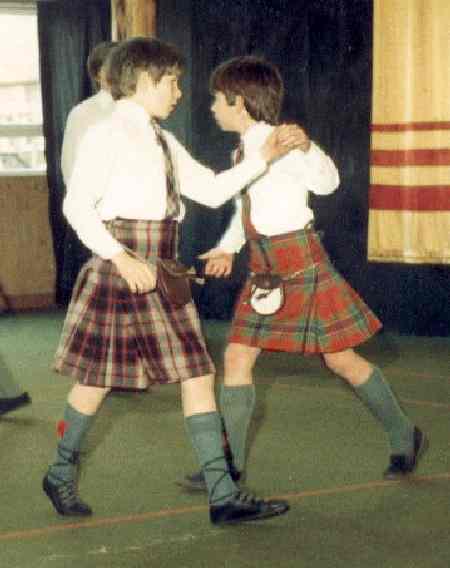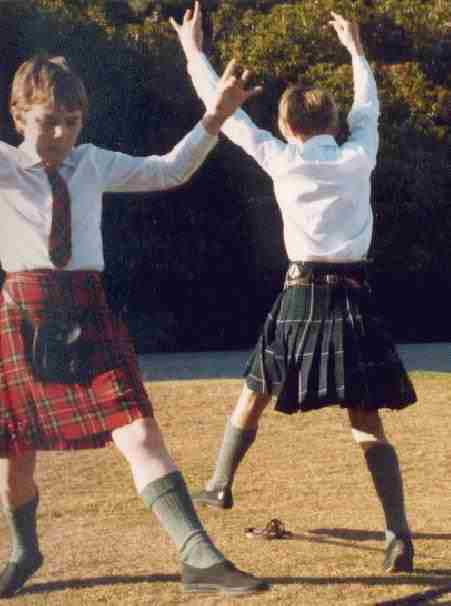
Figure 1.--These Scottish boys are practicing country dance at their preparatory school. The kilt was worn as the dress uniform at their school.


Figure 1.--These Scottish boys are practicing country dance at their preparatory school. The kilt was worn as the dress uniform at their school. |
Scottish country dancing is the modern form of the "country dancing" that was wide spread in both England and Scotland in the 18th century. It generally involves groups of about 6 to 10 people of mixed gender usually forming a "set". They dance to the driving strains of reels, jigs and strathspeys played on a variety of instruments--most commonly the fiddle, accordion, flute, piano, drums, and other instruments. Interestingly they rarely dance to bagpipes. The dance often combines solo figures for the "first couple" in a set with movements for all the dancers. There is, however, considerable variation in country dancing. One source reports that there are over 7,000 different dances have been catalogued and perhaps only about 1,000 are of lasting and non-local importance. These dances often derive from traditional sources such as old manuscripts and printed dance collections, but many are of recent derivation. This fusion of the traditional and the modern, and its ongoing evolution, are to many part of the attraction of Scottish country dance.
Scottish country dancing is the traditional ballroom dance of Scotland. Scottish country dancing is the modern form of the "country dancing" that was wide spread in both England and Scotland in the 18th century. It generally involves groups of about 6 to 10 people of mixed gender usually forming a "set". One observer explains that Scottish country dance is a kind of a cross between square or contra dance (although there is no caller) and ballet. Scottish country dancing as it developed is mote less structured than English country dance. The Scottish version has "steps" that must be learned. This means that it's less flowing and does not itself as much to spontaneous improvisation. Unlike Scottish Highland dances, which are usually solos to bagpipe music, country dance is conducted in sets of two to five couples. Everyone changes partners for each dance.
While indigenous dance forms existed in Scotland earlier, it was in the 18th century that what we now call country dance first appeared in Scotland. It was at this time that written instructions first appear. Scottish country dancing flourished throughout the drawing
rooms and ballrooms of Scotland. Despite the modern name, linking it to the country, when this dance form first appeared in Scotland during the 18th century--it was at first popular among the townspeople in Scottish cities. It was especially popular in Edinburgh. It gradually spread throughout the Scottish countryside. We note what appears to be Scottish country dance being taught at Robert Owen's New Lanark school in the 1820s. Country dance continued to be popular in the country even whenby the mid-19th century it was declining in popularity in the cities. Other more modern dances captured the popular fancy in fashionable citis, like the Waltz, One-step etc. While the origins were Englush, Scottish country dance gradually developed its destinct character over time as it was influenced by other popular Scottish dances such as Highland Reels.
The dances vary in tempo: lively and fast paced or slow and elegant. The three principal types are jigs (quick time), reels (quick time), and strathspeys (slow and lovely). They dance to the driving strains of reels, jigs and strathspeys played on a variety of instruments--fiddles and piano, along with recorders, bass, drums, and accordians are typical. Like much Celtic music, Scottish music is highly emotional--both the lively quicktime tunes and the hidden power of a strathspey. Interestingly they rarely dance to bagpipes.

Figure 2.--These Scottish boys are demonstrating country dance which is taught at their school. |
The dance often combines solo figures for the "first couple" in a set with movements for all the dancers. There is, however, considerable variation in country dancing. One source reports that there are over 7,000 different dances have been catalogued and perhaps only about 1,000 are of lasting and non-local importance. These dances often derive from traditional sources such as old manuscripts and printed dance collections, but many are of recent derivation. This fusion of the traditional and the modern, and its ongoing evolution, are to many part of the attraction of Scottish country dance.
In learning country dance, there are about a dozen basic figures that will get te beginning dancer through quite a large number of dances. Many dances have their own quirks and specialities which makes them a bit tricly to learn, but this makes them unique and fun to dance. There is more emphasis on "steps" in country dance than in, Ceilidh and some other dance forms. One country dancer believes that the basic techniques can be learned at a week-end workshop or by evening practice sessions over a few months.
Scottish country dancing is a form of social dancing. Dancers get to dance with seven or so people at once instead of just with one partner. As one dancer points out, smiles and eye contact are almost mandatory. For adults, there are workshops, balls and social dances being held in places all over the world. It is nice to be able to travel and join a Scottish country dance group for a night nearly everywhere you go.
We are not sure how country dance is taught in Scotland. We know that it is taught at many private Scottish schools. Often the kilt is worn as a dress uniform at these schools. Thus the boys will have a kilt and do not have to buy one especially for country dancing. We do not know to what extent country dancing is taught at state schools. It probably is taught at state primary schools, but many of the boys will not have kilts. It is less likely to be taught in state secondary schools, but this is just sdpeculation on our part at this time. Many Scotts appear tomlearn country dance as adults.
Navigate the Historic Boys' Clothing Web Site:
[Introduction]
[Activities]
[Biographies]
[Chronology]
[Cloth and textiles]
[Clothing styles]
[Countries]
[Topics]
[Bibliographies]
[Contributions]
[FAQs]
[Glossaries]
[Satellite sites]
[Tools]
[Boys' Clothing Home]
Navigate the Historic Boys' Clothing Web chronological pages:
[The 1880s]
[The 1890s]
[The 1900s]
[The 1910s]
[The 1920s]
[The 1930s]
[The 1940s]
[The 1950s]
Navigate the Historic Boys' Clothing Web dance pages:
[Main Scottish dance page]
[Ballet]
[Irish step]
[Ballroom]
[Native American]
[Interperative]
[Greek]
[Tap]
Navigate the Boys' Historical Clothing kilt pages:
[Main kilt page]
[Kilt suits]
[Scottish kilts]
[Scottish boys clothing]
[Scottish school uniform]
[Highland dance]
[Irish kilts]
[Irish boys clothing]
[Irish step dancing]
[Greek kilts]
